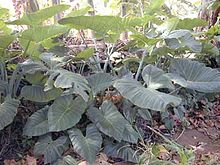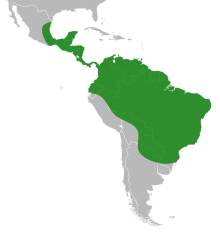Xanthosoma: Difference between revisions
Added map |
|||
| Line 16: | Line 16: | ||
|subdivision = ''About 50; see text'' |
|subdivision = ''About 50; see text'' |
||
|synonyms = ''Acontias'' <small>Schott</small><ref name="GRIN"/> |
|synonyms = ''Acontias'' <small>Schott</small><ref name="GRIN"/> |
||
|range_map = Xanthosoma distribution.svg |
|||
| ⚫ | |||
|range_map_caption = Range of the genus ''Xanthosoma''. |
|||
| ⚫ | |||
'''''Xanthosoma''''' is a genus of [[flowering plant]]s in the arum family, [[Araceae]]. The genus contains about 50 species that are native to tropical [[Americas|America]]. Several are grown for their [[starch]]y [[corm]]s, an important [[root vegetable|food staple]] of tropical regions, known variously as ''malanga'', ''otoy'', ''otoe'', cocoyam (or new cocoyam), ''tannia'', ''tannier'', ''yautía'', ''macabo'', ''macal'', ''taioba'', ''dasheen'', ''quequisque'', ''{{okina}}ape'' and (in [[Papua New Guinea]]) as Singapore taro (''taro kongkong''). Many other species (including especially ''X. roseum'') are used as [[ornamental plant]]s, and in popular horticultural literature are known as ‘ape or elephant ear (from the purported resemblance of the leaf to an [[elephant]]'s [[ear]]), although the latter name is sometimes also applied to members with similar appearance and uses in the closely related genera ''[[Caladium]]'', ''[[Colocasia]]'' (i.e., [[taro]]), and ''[[Alocasia]]''. |
'''''Xanthosoma''''' is a genus of [[flowering plant]]s in the arum family, [[Araceae]]. The genus contains about 50 species that are native to tropical [[Americas|America]]. Several are grown for their [[starch]]y [[corm]]s, an important [[root vegetable|food staple]] of tropical regions, known variously as ''malanga'', ''otoy'', ''otoe'', cocoyam (or new cocoyam), ''tannia'', ''tannier'', ''yautía'', ''macabo'', ''macal'', ''taioba'', ''dasheen'', ''quequisque'', ''{{okina}}ape'' and (in [[Papua New Guinea]]) as Singapore taro (''taro kongkong''). Many other species (including especially ''X. roseum'') are used as [[ornamental plant]]s, and in popular horticultural literature are known as ‘ape or elephant ear (from the purported resemblance of the leaf to an [[elephant]]'s [[ear]]), although the latter name is sometimes also applied to members with similar appearance and uses in the closely related genera ''[[Caladium]]'', ''[[Colocasia]]'' (i.e., [[taro]]), and ''[[Alocasia]]''. |
||
Revision as of 20:31, 6 April 2014
| Xanthosoma | |
|---|---|

| |
| Xanthosoma roseum | |
| Scientific classification | |
| Kingdom: | |
| (unranked): | |
| (unranked): | |
| Order: | |
| Family: | |
| Subfamily: | |
| Tribe: | |
| Genus: | Xanthosoma |
| Species | |
|
About 50; see text | |

| |
| Range of the genus Xanthosoma. | |
| Synonyms | |
|
Acontias Schott[1] | |
Xanthosoma is a genus of flowering plants in the arum family, Araceae. The genus contains about 50 species that are native to tropical America. Several are grown for their starchy corms, an important food staple of tropical regions, known variously as malanga, otoy, otoe, cocoyam (or new cocoyam), tannia, tannier, yautía, macabo, macal, taioba, dasheen, quequisque, ʻape and (in Papua New Guinea) as Singapore taro (taro kongkong). Many other species (including especially X. roseum) are used as ornamental plants, and in popular horticultural literature are known as ‘ape or elephant ear (from the purported resemblance of the leaf to an elephant's ear), although the latter name is sometimes also applied to members with similar appearance and uses in the closely related genera Caladium, Colocasia (i.e., taro), and Alocasia. The leaves of most Xanthosoma species are 40-200 cm long, sagittate (arrowhead-shaped) or subdivided into three or as many as 18 segments. Unlike the leaves of Colocasia, those of Xanthosoma are usually not peltate- the upper v-notch extends into the point of attachment of the leaf petiole to the blade.
Etymology
The name is derived from the Greek words ξανθὸς (xanthos), meaning "yellow," and σῶμα (soma), meaning "body." It refers to the stigma or yellow inner tissues.[2]
Reproduction
The inflorescence in Xanthosoma is composed of a spadix with pistillate flowers at the base, a belt of sterile flowers offered as a reward for pollinators in the middle and staminate flowers on the upper part. Prior to opening, the inflorescence is enclosed within a leaf-like spathe. When the inflorescence is ready to open, the upper part of the spathe opens and exposes the staminate area of the spadix; the basal area of the spathe remains closed, forming a spacious chamber (i.e., the spathe tube) that encloses the pistillate and sterile flowers (Garcia-Robledo et al. (2004, 2005a, 2005b)).
The inflorescences last for two nights and are protogynous in some species (though not others (Valerio (1988)), changing from the pistillate phase that attracts pollinators on the night it opens, to a staminate phase on the second night, when pollen is shed. When the inflorescence opens, it produces heat and releases a sweet scent attracting its pollinators, dynastine beetles (Cyclocephala spp.). Dynastines arrive covered with pollen from another inflorescence and remain in the spathe tube for 24 hours, pollinating the pistillate flowers as they feed on the sterile area of the spadix. On the second night, they come out of the tube and walk over the staminate flowers, getting covered with pollen, and then flying to a recently opened inflorescence nearby. (Garcia-Robledo et al. (2004, 2005a, 2005b)). Fruit maturation takes several months. Fruits start to develop within the shelter of the spathe tube. When the infructescence is mature, in some species, it arches back and downwards. In other species, it stays erect. Then, the tissue of the spathe tube rolls outwards, exhibiting the bright orange fruits and the velvety pink inner spathe surface.(Garcia-Robledo et al. (2004, 2005a, 2005b))
Crop uses
| 2006 | 2007 | 2011 | |
|---|---|---|---|
| 175000 | 176000 | 132100 | |
| 85954 | 86000 | 90336 | |
| 32964 | 38877 | 42961 | |
| 32068 | 32100 | 34771 | |
| 32000 | 32500 | 32918 | |
| World Total | 349152 | 350700 | 176000 |
| Data from The UN Food & Agriculture Organisation[3][4] | |||

Domestication of Xanthosoma species (especially X. sagittifolium but also X. atrovirens, X. violaceum, X. maffaffa, and others) is thought to have originated in northern lowland South America, then spread to the Antilles and Mesoamerica. Today, Xanthosoma is still grown in all those regions, but is especially popular in Cuba and Puerto Rico, where it is used in alcapurrias or boiled. It is grown in Trinidad and Tobago, Guyana and Jamaica to make the popular callaloo dish. It is also grown in West Africa, now a major producer, where it can be used as a replacement for yams in a popular regional dish called fufu. Xanthosoma is also grown as a crop in the Philippines.
Traditionally, Xanthosoma has been a subsistence crop with excess sold at local markets, but in the United States, large numbers of Latin American immigrants have created a market for commercial production. In general, production has yet to meet demand in some areas. In Polynesia, Xanthosoma (‘ape) was considered a famine food, used only in the event of failure of the much preferred taro (kalo) crop.
The typical Xanthosoma plant has a growing cycle of 9 to 11 months, during which time it produces a large stem called a corm, this surrounded by smaller edible cormels about the size of potatoes. These cormels (like the corm) are rich in starch. Their taste has been described as earthy and nutty, and they are a common ingredient in soups and stews. They may also be eaten grilled, fried, or puréed. The young, unfurled leaves of some varieties can be eaten as boiled leafy vegetables or used in soups and stews, such as the Caribbean callaloo.
People with food allergies sometimes find malanga is a great hypoallergenic flour alternative, because the proteins are less allergenic.[citation needed]
Selected species
- Xanthosoma atrovirens K.Koch & C.D.Bouché
- Xanthosoma brasiliense (Desf.) Engl. – Tahitian spinach
- Xanthosoma caracu K.Koch & C.D.Bouché – yautia horqueta
- Xanthosoma eggersii Engl.
- Xanthosoma helleborifolium (Jacq.) Schott – belembe silvestre
- Xanthosoma hoffmannii Schott – American taro
- Xanthosoma mexicanum Liebm.
- Xanthosoma pedatum Hemsl.
- Xanthosoma pubescens Poepp.
- Xanthosoma robustum Schott – capote
- Xanthosoma sagittifolium (L.) Schott – arrowleaf elephant ear, tiquizque, macal, nampi or malanga
- Xanthosoma striatipes (K.Koch & C.D.Bouché) Madison
- Xanthosoma undipes (K.Koch) K.Koch – tall elephant's ear
- Xanthosoma violaceum Schott – tiquisque
- Xanthosoma weeksii Madison
- Xanthosoma wendlandii (Schott) Schott[5][6]
Formerly placed here
- Caladium lindenii (André) Madison (as X. lindenii (André) Engl.)[6]
Gallery
-
Inflorescence of Xanthosoma sagittifolium
-
Inflorescence of X. daguense
-
Beetle pollination in X. daguense
-
Infructescence of X. poeppigii (Peruvian Amazonas); X. daguense (Western Cordillera of Los Andes, Colombia)
References
- ^ a b "Genus: Xanthosoma Schott". Germplasm Resources Information Network. United States Department of Agriculture. 2003-07-09. Retrieved 2012-07-13.
- ^ Quattrocchi, Umberto (2000). CRC World Dictionary of Plant Names. Vol. Volume IV R-Z. Taylor & Francis US. p. 2849. ISBN 978-0-8493-2678-3.
{{cite book}}:|volume=has extra text (help) - ^ "ProdSTAT: Crops". FAOSTAT Database. UN Food & Agriculture Organisation. Retrieved 2009-04-30.
- ^ http://faostat.fao.org/site/339/default.aspx
- ^ "Xanthosoma". Integrated Taxonomic Information System. Retrieved 2012-07-13.
- ^ a b "GRIN Species Records of Xanthosoma". Germplasm Resources Information Network. United States Department of Agriculture. Retrieved 2012-07-13.
- Garcia-Robledo, Carlos; et al. (2004), "Beetle pollination and fruit predation in Xanthosoma daguense (Araceae)", Journal of Tropical Ecology, 20 (4): 459–469, doi:10.1017/S0266467404001610
- Garcia-Robledo, Carlos; et al. (2005a), "Equal and opposite effects of floral offer and spatial distribution on fruit production and pre-dispersal seed predation in Xanthosoma daguense (Araceae)", Biotropica, 37 (3): 373–380, doi:10.1111/j.1744-7429.2005.00049.x
- Garcia-Robledo, Carlos; et al. (2005b), "Geographic Variation and Succession of Arthropod Communities in Inflorescences and Infructescences of Xanthosoma (Araceae)", Biotropica, 37 (4): 650–656, doi:10.1111/j.1744-7429.2005.00082.x
- Valerio, C. E. (1988), "Notes on the phenology and pollination of Xanthosoma wendlandii (Araceae) in Costa Rica", Biotropica, 36: 55–61




